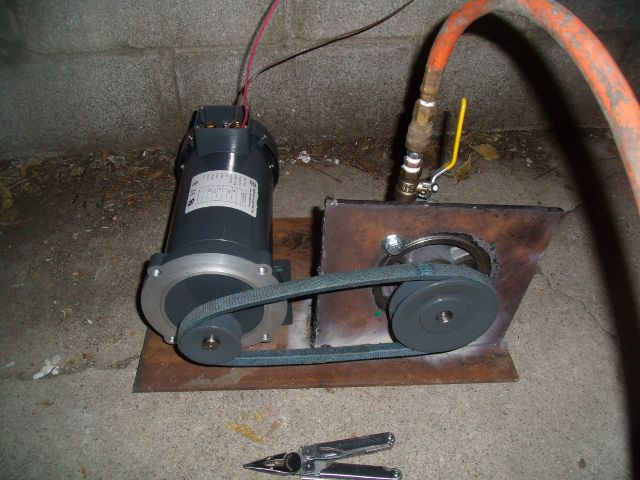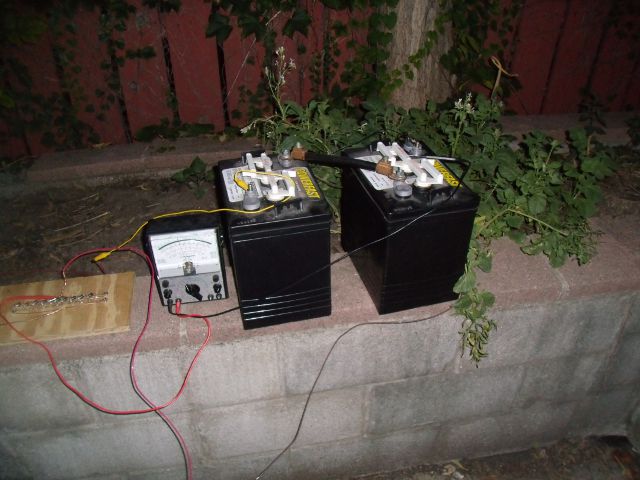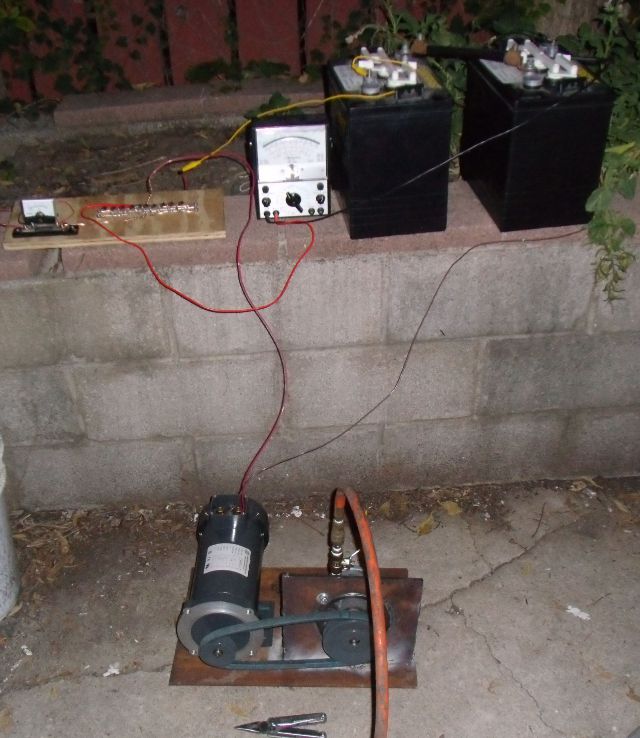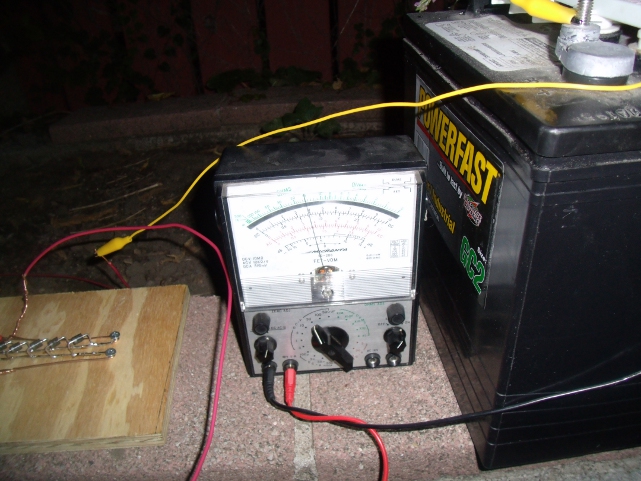Well I had a bit of time this Saturday with my son, so we needed a small project to keep us out of trouble. I have been so busy as of late that I've had little time to even follow the board, let alone post or build anything of utility, but I had a Saturday with my son, a few hours to kill, and a 1.7 HP air motor collecting dust. We also had a 1hp 24V pm motor I had recently gotten from another project, so this seemed like a natural fit to give it a try. I sold him on the idea that we could probably build a charger that would run his x-box 360 on compressed air. We already have run it on solar in a tent when camping just because we could, but compressed air might be a nice science fair project for him at some point, and it has not been the easiest to keep his interest in the solar and renewable energy projects that I enjoy as a hobby.
I lack the craftsman skills of many members here, and I did not drag the camera out until we had it all put together, but I took a few pictures and made this post in case it is of interest to anyone, or anyone has any good ideas to improve or modify it.
I rigged up a couple of fittings on the air motor to connect it with the quick connect hose on the compressor and a valve to throttle it and we gave it a whirl. I couldn't find the muffler for the exhaust, and I didn't add a filter and oiler for testing, but it purred to life with a sound like a gas motor scooter and the shaft spun rapidly. It was an interesting start for us.

We had a sheet of 12 by 48 inch 1/4 inch plate steel rusting in the basement of one of the buildings so I collected that up and we cut a piece off to make a base. The air motor was a Gast 4AM series motor with a C56 mount, so I had to cut a hole in the center for the motor to mount to. We did not have anything the exact size, but we found an old varnish can to use as a rough template to come close and winged it. It worked out. I cut the scrap into two gussets to hold the motor mount plate to the base. All of that took a lot less time than drilling holes to mount the air motor as it turned out.
First we drilled a couple of holes to mount the air motor, and after a trip to the hardware store to find a couple of short 3/8 inch bolts to hold it in place we bolted it in. Next we placed the pulleys we had on the motors. The ratio of the pulleys should be the ratio of the diameters. I had thought they would make a two to one ratio, but empirically it wound up being about 1.75 to 1. The air motor has quite a range of speed, although maximum torque is at about 250RPM and the maximum speed on the ratings is at 3000rpm. The 24V motor is one HP at 1750RPM according to the specs so we tried putting the larger pulley on the air motor and the smaller pulley on the 24V motor, figuring the 24V motor would bog down the 24V motor and hold down its speed once it hit cut in voltage. The 24V motor had a foot mount with slotted holes. We lined the motors up with the belt on them so that we could drill and tap holes for the 24V. motor. We drilled and tapped two of the holes on an angle, I really do need to sharpen the drill bits on the set at my house. We only completed about half of the mounting holes, but I figured it was enough for a simple test and we could add the rest later and besides it would have to come apart to be painted anyway. By now it was starting to get dark, where does the time go?

We dragged out a couple of six volt golf cart batteries and connected them in series for 12V and I rigged a multimeter to keep tabs on the voltage.
The next problem was that we did not have a large rectifier for this, although I did have a spare 30 amp meter I could borrow. I did have a bunch of diodes from I had bought as surplus for use on solar panels. We wound up rigging about ten of those in parallel and mounting them along with the amp meter on a small plywood block to test with.

We wired up the output of the 24V motor through the rectifier and amp meter on the positive side and directly through the battery for the negative output. We tested the polarity by using a red led across the leads and spinning it by hand. I switched the multimeter to be hooked across the input to the rectifiers and the negative of the battery to monitor the voltage of the generators output. Once we had everything together an old 20gallon air compressor was fired up and charged to 120PSI. The pressure regulator was set to 100PSI although I worried about the line resistance in the 100 feet of 3/8 inch air hose, which is really two 50ft sections with 1/4 inch fittings on the ends. This is the entire setup.

We through the valve and it came to life, spinning up as the valve was opened. The voltage on the meter came up to about 12 volts.

It flared up past ten amps and then quickly settled to 10 amps. I could not get it to output more than that.

The compressor kicked on as the tank pressure depleted, and it seemed to me that the 1/3 hp motor of the compressor was just able to keep up with the air needed for the 10 amps into the battery, which would make for rather dismal efficiency, which is not that surprising. If I were to ever implement a storage system where air was compressed to store energy and expanded to put it back into use, I would look for some way of either capturing the heat generated by compression, or some other heat source to add back to the gas before it was expanded to increase the efficiency.
If I get the chance, although it will probably be a couple of weeks, I will try to perform some rudimentary measure of the round trip efficiency. I have about a half a kilowatt hour of energy storage in ultracapacitors within the range that my sw4048 inverter can handle, and a system where I compressed air with the excess in the day and recaptured it at night to keep the bank charged up longer would be of some utility to me, although I would have to obtain an effective muffler for the air motor and probably find a more efficient compressor as well to have any hope of making it practical. The motor is 24V, and the test was at 12V, but since the induced voltage should be proportionate to the rate of change of the magnetic field, so long as the winding insulation can handle it, and the bearings as well, generating a higher voltage should be a matter of changing the gear ratio between the air motor and the generator. Since it is 1750 at 24V and I usually have to spin them a bit faster to get the voltage back out of them, I am guessing that if it is spun up at about 3600 rpm it will probably be putting out about 48V, but that is just a guess at this point.